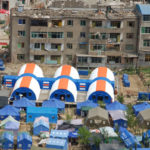Ecuador and Japan Earthquakes Highlight Need for Mobile Medical Facilities
Deadly earthquakes have struck regions of Ecuador and Japan in the past week, resulting in hundreds of deaths, thousands injured, and leaving a combined total of almost 450,000 in need of aid and/or shelter. The extreme and sudden effects of large scale disasters highlight a need for mobile medical facilities and shelter accommodation that can be rapidly deployed to disaster sites.
Japan’s Kyushu region was hit by a magnitude-7.0 earthquake on Saturday, April 16th, after sustaining a 6.2 quake two days before. A combined total of about 41 people have been killed from these earthquakes, 968 are injured, and almost 92,000 people have been evacuated to emergency shelters.
The devastation is far worse in Ecuador, where Saturday’s 7.8 magnitude earthquake killed 587, left thousands injured, and displaced tens of thousands from their homes. A second, 6.0-magnitude quake struck on Thursday, April 21st, causing further damage and injury to an already devastated disaster zone, where food, water and medicine are lacking. An estimated 350,000 people are in need of aid.
In the wake of disasters like the Ecuador and Japan earthquakes, governments and first responder agencies benefit significantly when they have mobile medical and hospital facilities on hand and ready for immediate deployment. Disaster response and survivor support after earthquakes and other disasters require readily available facilities in order to enable effective disaster recovery efforts. The most common facilities needed include:
- Hospital surge units to support overflow at existing medical facilities, if not structurally compromised.
- Stand-alone and complete mobile hospitals capable of providing basic first aid services to more advanced-level health care like ICUs (intensive care units) for carrying out life-saving operations and treating serious injuries in rural areas or in disaster zones where existing medical facilities are no longer functioning and/or damaged.
- Morgue systems to appropriately and respectfully manage deceased victims.
- Portable shelter systems for victim treatment and/or accommodation.
Effective response to unexpected disasters like earthquakes requires mobile medical facilities be highly portable and rapidly deployable. BLU-MED Response Systems® (BLU-MED) is the leading provider of engineered mobile hospitals and medical facilities. BLU-MED portable hospitals and medical shelters have been deployed for the following disasters:
- Indian Tsunami 2004 – Sri Lanka
- Hurricane Katrina 2005 – Louisiana, United States
- Kashmir Earthquake 2005 – Pakistan
- Sichuan Earthquake 2008 – China
- Sudan Crisis 2009
- Léogâne Earthquake 2010 – Haiti
- Bio-Bio Earthquake 2010 – Chile
- Joplin Tornado 2011 – Missouri, United States
- Kenya-Somalia Refugee Crisis 2011
- Super Storm Sandy 2012 – New York, United States
- Syrian Refugee Crisis 2013 – Jordan
BLU-MED maintains a disaster response stockpile that is capable of being deployed and operational within 72 hours, anywhere in the world.
Governments and first response agencies in disaster-prone areas like Ecuador and Japan located along the Ring of Fire, would benefit by having mobile hospitals and medical shelters be a part of their emergency preparedness or emergency response systems for immediate use in the wake of disasters. This level of preparation is particularly important should primary healthcare facilities be destroyed, as has happened in the recent earthquakes.
